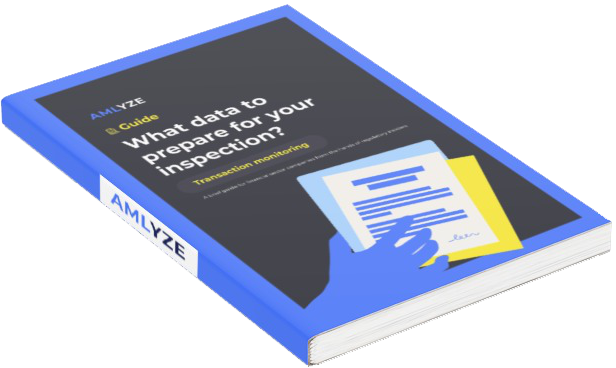The intersection of crypto currencies and anti-money laundering (AML) measures represents a critical frontier in the financial world, where the decentralized nature of digital currencies presents unique opportunities and challenges for financial institutions, cryptocurrency users and regulators.
Cryptocurrencies offer greater financial inclusion and efficiency potential. However, their decentralized nature poses challenges in combating illicit financial activity.
This blog post from AMLYZE explores the importance of AML practices in the crypto industry. It highlights how these mechanisms prevent money laundering and enhance sector credibility.
Why are AML procedures important in the crypto industry?
Cryptocurrencies offer many benefits, such as wider financial inclusion, faster and more efficient transactions, and greater financial autonomy. However, its decentralized nature also poses significant risks by potentially facilitating illicit financial activities.
The potential for cryptocurrency abuse
The characteristics of cryptocurrencies, including low-cost, direct transactions, make them increasingly attractive to those seeking to launder money. The ability to move illicit funds through digital currencies often leaves a minimal digital footprint, making detection difficult.
The digital currency ecosystem has become a magnet for bad actors.
The availability of certain cryptocurrencies that offer complete anonymity only increases the risk. While the innovative appeal of cryptocurrency attracts legitimate users, it inevitably attracts individuals with malicious motives.
The importance of AML measures in crypto world
This is where AML protocols become critical. They serve as essential governance mechanisms to combat financial crime in the cryptocurrency space. By implementing AML measures, the cryptocurrency industry protects its platforms and users. It also enhances its overall credibility and encourages wider adoption.
How are digital currencies regulated?
Globally, regulators have recognized the importance of bringing cryptocurrency firms under the same regulatory umbrella as traditional financial firms. This move aims to prevent financial crime. However, the application of these rules varies significantly from region to region. Some jurisdictions have introduced detailed guidelines covering the entire cryptocurrency sector, while others have established specific legal requirements for crypto-related activities. In addition, attitudes towards cryptocurrency regulation can vary even within the same country, reflecting different perspectives on the issue. The rapid development of the technology that underpins digital assets necessitates a constant review of regulations. Unfortunately, these changes can open up new loopholes for criminal exploitation, allowing them to develop new evasion techniques.
In Asia in particular, regulators have been proactive in strengthening AML measures for cryptocurrency exchanges. Since 2018, the Monetary Authority of Singapore (MAS) has intensified its interactions with the industry to improve compliance and monitoring mechanisms. In the European Union, the introduction of the Fifth Anti-Money Laundering Directive (5 AMLD) marks the establishment of crypto-specific regulatory frameworks. As these frameworks evolve, crypto businesses are increasingly adopting monitoring and compliance solutions to keep pace with regulatory developments. By complying with these AML standards, cryptocurrency exchanges are demonstrating their commitment to preventing financial crime and fostering a safer user environment.
EU and FATF approach
In EU countries – The Markets in Crypto-Assets Regulation (MiCA) came into force in June 2023, establishing a single set of EU market rules for crypto-assets. The Regulation covers crypto-assets that are not currently regulated under existing financial services legislation. Key provisions for issuing and trading crypto-assets (including asset reference tokens and e-money tokens) cover transparency, disclosure, authorisation and supervision of transactions. The new legal framework will support market integrity and financial stability by regulating public offers of crypto-assets and ensuring that consumers are better informed about the risks involved.
The Financial Action Task Force (FATF) finalized an interpretative note to Recommendation 15 in 2019, updating and expanding the guidance to clarify the application of FATF standards to virtual asset transactions. The note augments the existing regulatory framework for traditional financial products, following industry consultation. The Recommendation, which will be adopted in June 2019, will subject virtual assets and virtual asset service providers (VASPs) to comprehensive regulation similar to traditional financial products to prevent money laundering and terrorist financing.
Key updates from the FATF Interpretative Note:
- Definitions and scope: The Note expands the definition of virtual assets and VASPs and broadly categorizes virtual assets to encompass different forms of value. Member States are required to apply the measures recommended by the FATF to virtual asset activities and VASPs.
- Risk identification: States are expected to identify and assess the money laundering and terrorist financing risks within the virtual asset space and VASP operations. Appropriate measures should be taken to effectively mitigate these risks.
- Licensing and registration: VASPs must be licensed or registered, with mechanisms in place to prevent criminal elements from controlling or significantly influencing these entities. Actions without proper licensing or registration should be sanctioned.
- Single registration system: Countries should avoid imposing separate licensing for entities that are already recognised as financial institutions but are authorized to engage in VASP activities under their current licenses.
- Regulatory oversight: VASPs must comply with AML/CFT regulations, with countries ensuring appropriate supervision. This includes risk-based supervision, the power to conduct inspections, collect information and enforce sanctions for non-compliance.
- Enforcement and sanctions: A range of sanctions should be available to penalize VASPs that fail to comply with AML/CFT standards, including their management, in line with FATF Recommendation 35.
These changes significantly enhance the regulatory framework for virtual assets and aim to tighten control over financial crime in the digital asset space.
Ensuring AML for crypto exchanges
Compliance with AML protocols is paramount in the digital currency sector for many reasons. Cryptocurrency organizations, much like traditional financial institutions, employ similar strategies to ensure compliance. Central to these strategies is a risk-based methodology that begins with a detailed assessment of potential risks, which requires frequent updates due to the rapid evolution of regulatory frameworks.
Cryptocurrency businesses face unique challenges, such as the threat of money laundering and multiple money laundering schemes. Perpetrators use a variety of tactics, such as off-blockchain transactions, to mask illicit activity, creating further compliance hurdles. In addition, the lack of organizational structure and resources in smaller crypto companies compared to their larger counterparts poses a challenge. This challenge lies in retaining qualified compliance professionals, as they expect higher compensation.
The importance of AML compliance for digital currency exchanges is heightened by the escalating regulatory measures being enforced globally. Jurisdictions such as China and South Korea are implementing strict controls on crypto operations, in contrast to the more permissive environments of Japan and Switzerland.
FATF role in developing guidelines
The FATF has been instrumental in formulating AML guidelines tailored to the crypto market, aimed at protecting both entities and individual users within the ecosystem. These regulatory efforts are critical in influencing global and local perceptions of the cryptocurrency industry. Industry leaders advocate for regulation that balances AML compliance with the preservation of decentralized financial systems.
Digital currency companies are at a pivotal point, facing the introduction of comprehensive regulatory structures by governments around the world. In anticipation of these changes, companies must stay abreast of the latest AML compliance trends. They should also anticipate future developments. This foresight will enable them to strategically gain the trust of regulators and potential customers.
Vigilance in monitoring regulatory changes – horizon scanning – is essential for firms to proactively allocate the necessary resources to compliance. Staying ahead ensures that sufficient budgets and staff are allocated to meet emerging regulatory requirements. Understanding the nuances of new AML standards specific to the crypto space is critical. It may require updates to existing legislation or the introduction of new regulatory frameworks in different jurisdictions. Although certain challenges are common to all industries, crypto businesses must navigate specific regulatory intricacies that are unique to their operations. By managing these complexities, firms reaffirm their commitment to compliance. They also build a resilient foundation for continued growth amidst the dynamic regulatory environment.
Achieving compliance in the crypto world: key tactics
Navigating the regulatory landscape of the crypto sector requires a multi-faceted approach. Below are essential tactics, reorganized to effectively guide your compliance strategy
Keep abreast of regulatory updates
It’s critical to stay abreast of the latest developments and changes to the regulatory framework specific to the digital currency industry. By actively engaging in horizon scanning, you can anticipate upcoming adjustments. And you can prepare accordingly by ensuring the necessary resources and personnel are in place.
Implement AML screening practices
Use essential tools such as know your customer (KYC) processes, customer due diligence (CDD) assessments, and sanctions, politically exposed person (PEP) and adverse media screening. These methods are essential for verifying the identity of your users and identifying suspicious entities.
Adopt a risk-based strategy
Conduct detailed risk assessments to identify and prioritize the potential threats associated with money laundering and other financial crimes. It’s important to continually update these assessments to keep pace with the evolving regulatory landscape.
Acquire compliance expertise
Hiring professionals with compliance experience, who have backgrounds in banking, regulation and FinTech, can greatly enhance your ability to navigate the complex regulatory terrain and adhere to required compliance standards.
Leverage technology solutions
Leveraging advances in technology, such as artificial intelligence-powered tools, can streamline your compliance processes and improve financial crime detection and prevention. Tools such as Sanction Screening modules are instrumental in this regard.
Demonstrate your commitment to compliance
Proactively positioning your organization as compliant can build trust with regulators and potential customers. This includes adhering to regulatory standards, implementing best practices and ensuring transparency in all operations.
Prepare for the regulatory environment
Anticipating changes in regulatory frameworks is essential. By monitoring and allocating resources for forthcoming changes, you can make incremental adjustments to existing laws and regulations. Alternatively, you can develop new programs to keep pace with the evolving regulatory environment.
Key steps in achieving sanctions compliance
Take a look at five key steps your organization can take to successfully navigate the emerging challenge of digital currency sanctions compliance:
- Deploy effective blockchain monitoring solutions and use holistic screening.
- Manage your country risk
- Understand red flags
- Define your investigation strategy
- Implement a comprehensive risk management framework
Summing up, integrating AML measures into the crypto space is a dynamic and complex endeavor, requiring constant adaptation and vigilance from both regulators and crypto businesses. As the landscape evolves, the emphasis on AML compliance underscores the sector’s commitment to legitimacy and security. By navigating regulatory challenges and adopting strategic compliance tactics, the digital currency industry can foster a safer, more inclusive financial ecosystem. This commitment to AML compliance not only mitigates the risks associated with digital currencies, but also paves the way for the sustainable growth and acceptance of digital currencies as a legitimate component of the global financial system.
For more about AMLYZE transaction monitoring tools, also relevant for cryoto companies, can find here.
FAQs
1. What is AML in the context of cryptocurrency?
AML, or anti-money laundering, refers to laws, regulations, and procedures. They’re designed to prevent individuals from disguising illegally obtained funds as legitimate income. In the cryptocurrency sector, AML practices involve monitoring, reporting, and preventing suspicious activity. This activity could involve money laundering through digital currencies and assets.
2. Why is AML important for crypto exchanges and wallets?
AML is critical for cryptocurrency exchanges and wallets. It helps prevent financial crimes like money laundering and terrorist financing. By implementing AML measures, these platforms ensure that they do not facilitate illegal transactions. This not only helps maintain the integrity of the financial system but also builds trust among users and regulators.
3. How do crypto platforms implement AML measures?
Cryptocurrency platforms implement AML measures through various means. These include Know Your Customer (KYC) procedures, transaction monitoring, and reporting suspicious activity to relevant authorities. KYC involves verifying the identity of their users. Additionally, transaction monitoring helps detect unusual patterns that may indicate money laundering.
4. What are the challenges of AML in the cryptocurrency sector?
Key challenges include the anonymity and decentralization characteristics of digital currencies. These can make it difficult to track the flow of funds and identify the parties involved in transactions. In addition, the evolving nature of digital currencies complicates compliance efforts. So varying AML regulations across jurisdictions add to the complexity.
5. Can digital currencies be regulated for AML purposes?
Yes, regulatory authorities can and do regulate cryptocurrencies for AML purposes. Many countries are implementing regulations. These require cryptocurrency exchanges and wallets to comply with AML standards. These standards are similar to those of traditional financial institutions. They include the need to identify users, monitor transactions, and report suspicious activity.
6. What happens if a cryptocurrency platform fails to comply with AML regulations?
If a cryptocurrency platform fails to comply with AML regulations, it can face significant penalties. Consequently, these may include fines, suspension of licenses, or even criminal charges against its operators. Moreover, non-compliance can also damage the platform’s reputation, thereby resulting in a loss of users and partners.
7. How do AML regulations affect crypto users?
AML regulations may require digital currency users to undergo identity verification processes. They might need to provide additional documentation and face certain transaction restrictions. This can increase transaction time and reduce anonymity. These mechanisms are designed to prevent individuals from disguising illegally obtained funds as legitimate income.
8. Are there any global standards for AML in the cryptocurrency sector?
Yes, the Financial Action Task Force (FATF) has issued guidelines. These contain recommendations for countries to regulate cryptocurrencies and service providers for AML purposes. The aim is to establish a consistent approach to combating money laundering and terrorist financing in the cryptocurrency sector. The guidelines encourage countries to adopt similar regulatory frameworks.






